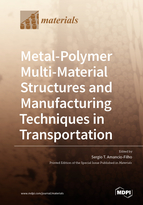Metal-Polymer Multi-Material Structures and Manufacturing Techniques in Transportation
A special issue of Materials (ISSN 1996-1944).
Deadline for manuscript submissions: closed (7 March 2020) | Viewed by 36385
Special Issue Editor
Interests: joining technology; additive manufacturing; materials science; welding metallurgy; polymer welding; composites; metals and hybrid structures
Special Issues, Collections and Topics in MDPI journals
Special Issue Information
Dear Colleagues,
The reduction of greenhouse gas emissions—particularly from fossil-fuel-powered vehicles—by means of weight savings and leaner fuel consumption, helps to curb environmental impacts. Such environmental concerns and restrictions imposed by regulations have motivated scientists and engineers to design lighter structures without compromising reliability. The demand for lightweight structures has been growing across a wide range of engineering solutions, for transport, renewable power generation and construction industries. In general, for a variety of industries and specifically in the case of transport, where both weight savings and increased energy efficiency are pursued, the use of high-performance engineering polymers and composites (e.g., glass- and carbon-fiber reinforced polymers), has gained considerable importance in hybrid, multi-material structures. In addition to their advantage in specific strength, composites possess outstanding corrosion resistance, high strength and fatigue performances and thermal stability. Furthermore, the search for lightweight solutions has also fuelled the development of more advanced aluminum, titanium, magnesium and high strength steel alloys, reducing the overall weight of a structure while maintaining high mechanical performance. Therefore, the observed trend for achieving weight reduction is a mixed material design.
The field of metal-polymer multi-material structures has been growing at an increasing and particularly fast pace in recent years. Several techniques have been or are being developed with the aim of being used for additively manufacturing or joining dissimilar materials in cost efficient manners. Despite the benefits of using metals, high-performance polymers and their respective composite materials in a hybrid structure, the manufacturing of these dissimilar materials presents a great challenge due to their distinct physicochemical properties.
Over time, various joining techniques have been developed including adhesive bonding, mechanical fastening, welding-based technologies or combinations of one or more of these individual techniques—known as hybrid joining technologies. More recently, a new manufacturing field has been created to directly assemble metal-composite structures. These technologies involve the hybridization of metallic parts with polymer processing—such as injection over molding—or composite lamination techniques. These allow the fabrication of complex parts with improved mechanical performance and strength-to-weight ratios. Within this scope, one field that has great disruptive potential for contributing to the rise of hybrid structures is additive manufacturing. The possibility of using new materials and their combinations to additively manufacture hybrid components with complex geometries, has gained a momentum across several industries.
This Special Issue intends to review the state-of-the-art in joining and additive manufacturing of metal-polymer multi-material structures. Short communications, critical literature reviews, and technical papers addressing the correlations between microstructure, process, properties and mechanical performance are intended. The submission of manuscripts reporting on new joining and additive manufacturing processes as well as case-studies of real parts or applications in transportation are especially welcome. Examples of metal-composite multi-materials may include aluminium, titanium, magnesium, high and ultra-high strength steels combined with thermoset, thermoplastics and their composites. Manuscripts dealing with the fundamental understanding of the processing steps and material-related changes—e.g. microstructure, physical-chemical, corrosion resistance, natural and accelerated aging, crash and damage tolerance properties, on experimental, mathematical and computational areas will be considered for publication. New thermal joining techniques using, but not limited to, friction-, laser-, induction- and ultrasonic-based energy, as well as new 3D printing, wire-based and powder-based additive manufacturing techniques for direct assembly of metal-polymer multi-materials, will receive special attention in the reviewing process.
Prof. Dr. Sergio T. Amancio-Filho
Guest Editor
Manuscript Submission Information
Manuscripts should be submitted online at www.mdpi.com by registering and logging in to this website. Once you are registered, click here to go to the submission form. Manuscripts can be submitted until the deadline. All submissions that pass pre-check are peer-reviewed. Accepted papers will be published continuously in the journal (as soon as accepted) and will be listed together on the special issue website. Research articles, review articles as well as short communications are invited. For planned papers, a title and short abstract (about 100 words) can be sent to the Editorial Office for announcement on this website.
Submitted manuscripts should not have been published previously, nor be under consideration for publication elsewhere (except conference proceedings papers). All manuscripts are thoroughly refereed through a single-blind peer-review process. A guide for authors and other relevant information for submission of manuscripts is available on the Instructions for Authors page. Materials is an international peer-reviewed open access semimonthly journal published by MDPI.
Please visit the Instructions for Authors page before submitting a manuscript. The Article Processing Charge (APC) for publication in this open access journal is 2600 CHF (Swiss Francs). Submitted papers should be well formatted and use good English. Authors may use MDPI's English editing service prior to publication or during author revisions.
Keywords
- Lightweight Structures
- Joining Processes
- Engineering Polymers
- Fiber Reinforced Polymers
- Polymer Composites
- Multi-Material Structures
- Metal-Polymer Connections
- Additive Manufacturing







